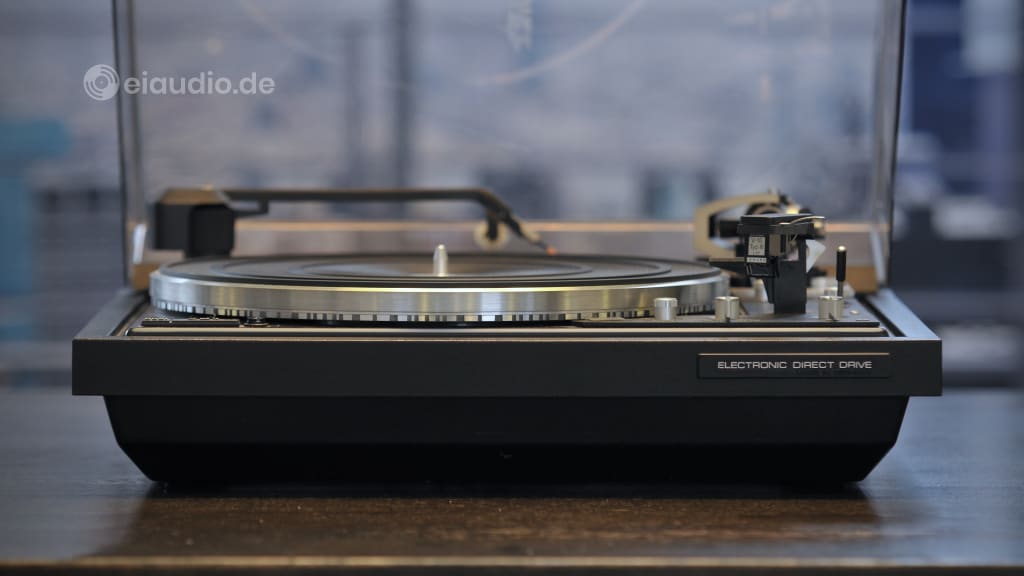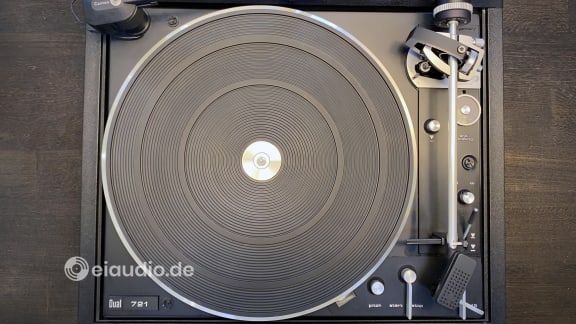Dual CS 721
Published: 27/07/2022
Manufacturing date: 1976
Author: Karsten Hein
Category: Gear & Review
Tag(s): Turntables
The CS 721 was Dual’s flagship turntable towards the end of the 1970s and is, by many, considered to rank among the best Dual turntables ever made. When there is disagreement between the experts, this is usually about the merits of the drive system. Proponents of idler wheel turntables, the ‘Treibrad Classics’, would cite Dual models CS 1219 and CS 1229 as their favourites, whereas belt-drive fans would give preference to the CS 5000 or CS 7000 Golden. The CS 721 was a direct drive design (DD) and, in all fairness to the other two camps, had the most audiophile specifications in terms of rumble, wow, and flutter of them all. However, we do not listen to specifications but to music, of course. And I must confess that I do love the straightforward sound of our smaller CS 505-3 as well.
In its most affordable form, the CS 721 was not the most beautiful deck on the market. Its plinth was a base of cheap plastic that was skirted with a frame of laminated wood. Dual had to rely on its good name in audiophile circles in order to be able to sell its products next to the sleek and slim looking Asian designs from Technics, Pioneer, Sony, etc. In fact, the new lack of genuine wood on the products of the German manufacturer from the Black Forest was already a tribute to the increasingly price-driven market. However, the pressure to surpass its competition by means of sophistication assured the CS 721 some highly sophisticated features that are rarely found on turntables of any age.
One obvious highlight of the CS 721 was its tonally rich made-for-Dual Shure V15-III cartridge with its Super-Track-Plus stylus. The Shure V15-III was an excellent tracker with a low stylus force of merely 0.75g to 1.25g. The cartridge exhibited the usual Shure bass qualities while performing smoothly across an extensive frequency range from 10 Hz to 25,000 Hz. Sadly, the original Shure stylus was too worn out on our model, so that I had to look for a suitable replacement. My first impulse was to take the plunge on a Jico SAS stylus with boron cantilever; however, an indefinite delivery impasse from Jico forced me to settle for a Tonar Shibata stylus instead. Shibata needles were originally developed for use with quadrophonic recordings, reached deeply into the record groove, and, similar to Jico’s SAS styli, were capable of great nuance. However, listening to the two styli in direct comparison, it was hard not to favour the worn-out Super-Track-Plus for its amount of delicacy.
I also decided that I was going to improve the plinth of the turntable to isolate any physical vibrations from the floating chassis, as the thin plastic vat did not seem sufficient for the job. You will find a full article on the project in the 'Explorations' section of this blog. The result was a solid wood plinth that held the original structure suspended whilst silencing any vibrations to the plastic through the use of rubber foam. I used tri-ball absorbers to further isolate the plinth from potential vibrations caused by steps, slamming doors, or the other Hi-Fi units in the rack. The result was a tonally rich, precise, and undisturbed sound, just as one would expect from one of Dual’s top players.
Next to its precise and quiet motor, rigid tonearm, and legendary Shure cartridge, the CS 721 offered a host of adjustable settings that were class-leading at its time. Like all Duals of this period, it offered three transport screws to clamp down the chassis during transport. I always loved this feature on the Dual decks, as I had to spend lots of time transporting them in the car. Even the dust cover lift could be adjusted on the CS 721 just in case the spring should soften with age. The tonearm had a 2-fold dampened, adjustable counterweight and could additionally be altered in lateral length to perfectly accommodate most cartridge weights.
The vertical tracking of the CS 721 tonearm could be calibrated via a lever. Most other turntables only offered socket screws for the purpose. In a similar way, one could adjust the lift angle and the precise touchdown position of the stylus on the record groove. The touchdown speed could be adjusted to suit the weight of the cartridge. It was interesting to note that the manual lift function was not affected by adjustments to the lift height, as this, too, was set via a separate control. When playing back records, the CS 721 could be set from single to infinity mode, by which it would repeat playing a record until it was manually interrupted. When taking a closer look at the headshell, I was surprised to find that the cartridge was clamped into position and additionally secured by two screws. I learned that there had been two headshells sold of which only one could be adjusted. So I ended up purchasing an additional TK-24 headshell to have more freedom in my settings.
While the tonearm was adjusted by changing the lateral length of the arm and then via the knurled ring of the counterweight, a further adjustment ring was available to set the stylus down force. In combination, this was one of the most sophisticated settings I had ever seen. Anti-skating could be adjusted to suit conical and bi-radial styli. It was conceivable that the CS 721’s vast combination of settings would have been more confusing than helpful to some owners. On the other hand, listening to records had always been similar to fly fishing, with lots of time, skills, and effort needed to achieve a somewhat short-lived result. In other words, the Dual was anything but plug-and-play. All the more, it was gratifying to own and listen to, once the perfect setting was achieved, especially with its new walnut plinth.
Related Articles:
< Constructing the Plinth | Dust Cover Restoration >
Dual Company History
Christian and Joseph Steidinger started out as a manufacturer of clockwork and gramophone in the German Back Forest town of St. Georgen in 1907. The original company simply bore the family name, until they rebranded as Dual in 1927. The new company name was chosen in reference to their signature “dual-mode” power supplies in which they were true pioneers. Gramophones featuring these supplies, could either be powered by electricity or wound up for playback. Given their early success as a parts supplier, the Steidinger brothers began designing their own turntables.
During the German economic recovery that followed World War II, Dual became the largest producer of turntables in Europe. The German economy still enjoyed a price advantage over the rest of Europe and became known for high-quality once again. The Steidinger brothers had to hire up to 3,000 factory staff in order to keep up with the growing demand in entertainment devices in the world. Although Dual stretched the brand into other consumer electronics items, their turntables have remained iconic to this day.
The original Dual company went bankrupt in the early 1980s, following a decade of fierce competition from cheap and sophisticated imports from Japan. It was sold to the French electronics group Thomson SA. In 1988, the German company Schneider Rundfunkwerke AG bought Dual and then spun off the ‘Dual Phono GmbH’ to Alfred Fehrenbacher in 1993. Fehrenbacher produces Dual turntables 'Made in Germany', in the Black Forest town of St. Georgen, based on Dual’s original product lines until this very day.
Specifications
- Turntable type: Fully automatic
- Motor: direct drive, electronically controlled
- Motor type: Dual EDS 1000-2
- Speeds: 33.33 and 45rpm
- Platter weight: 1.5 kg, aluminum die cast
- Platter weight with rotor: 3.0 kg
- Platter size: 305mm, dynamically balanced
- Pitch control: +/- 10%
- Wow and flutter: < 0.03%
- Rumble: > 70dB
- Tonearm: extended tubular, 2x damping
- Tonearm effective length: 222mm, height adjustable
- Cartridge: Shure V15 III (1973 - 1987)
- Stylus pressure: 0.75 to 1.25g (1.0g)
- Stylus type: Microline, elliptical diamond
- Channel separation: 28dB @1kHz
- Frequency range: 10 - 25,000 Hz
- Cartridge inductance: 500 mH
- DC resistance: 1,350 Ohms
- Resistance: 47 kOhms
- Output: 3,5 mV @1kHz
- Cartridge weight: 6.0 g
- Turntable Weight: 7.8 kg
- Dimensions: (W) 424 mm x (H) 150 x (D) 368 mm
- Country of manufacture: Germany
- Year(s): 1976 - 1979






